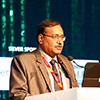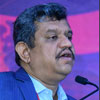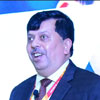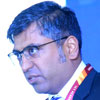About Bridge
BRIDGE a flagship conference of ICT Academy aims to bridge the industry-academia gap. BRIDGE is a confluence of Educators, Researchers, Corporate, Solution Providers, NGOs and Policy Makers to find possible solutions and answers to some of the most challenging, critical and relevant questions we face in the journey towards transforming India. The conference serves as a platform in providing a strategic view on the trends that shape the educational ecosystem. The conference engages various stakeholders to seize opportunities to transform from theories to practice and become indispensable in the new digital world. Started in the year 2011, the conference has been receiving an overwhelming response from all the stakeholders of the knowledge ecosystem. Having reached multiple cities in India, BRIDGE has emerged to be The Largest Industry-institute Interaction Event of Asia with 38 editions completed as of March 2019.
Future of work
Disruptive innovations and advanced technologies are creating new industries, methods and models, thereby destroying the old ones. New technologies including Data Analytics, Cloud, Artificial Intelligence, Mobility and Social Networks are having a huge impact on how people communicate, collaborate and work. As generations collide, workforces become more diverse and people work longer; traditional career models may soon be a thing of the past. Many of the roles and job titles of tomorrow will be ones we’ve not even thought of yet. This brings in huge responsibilities for all stakeholders in education to develop and deploy strategies for preparing the right talent for the future global opportunities.
ICT Academy BRIDGE Conference brought together industry experts, academic leaders and government policy-makers to address how to achieve strategic readiness to capitalize on the opportunities offered by the digital workplace and develop talent for the all new future of work.
BRIDGE - Future of Work was a dedicated conference that featured organizations and experts doing innovative, pioneering work in developing the future workforce. It is the only event addressing the stakeholders and leaders in the process of bridging the industry & academia towards the Future of Work.
This conference explored technological trends and how they are reshaping the future of work, forecasting key areas of job disruption and evaluating ways in which policy-makers, academia & industry leaders can adapt regulatory and economic frameworks in response. In addition, speakers deliberated on the existing strategies and required rethinking of the working world.

M Sivakumar
Chief Executive Officer,
ICT Academy
Bridge is happening across India in 12 metropolitan cities. Now in Guwahati, we are conducting the 39th edition of Bridge conference. When the Chairman of AICTE attended the Bridge conference at Coimbatore as a speaker, he just expressed an idea of exploring the northeastern region of India. A few years later, we partnered with AICTE for a project, “Employability Enhancement Training Program (EETP)” to train the students of the northeast on the latest technology skills. Now in the northeast India, we have established a team of more than 10 members who take care of the entire operations in the region.
Few years back, we had the event Bridge at Tirunelveli, where the Chairman of Syntel (IT company), was one of the speakers On that occasion, we were discussing on the strengths of the Tirunelveli, and I said spontaneously, “Why shouldn’t Syntel have an office in the city of Tirunelveli, which has the potential of skilled resources?”, it was just a casual talk; but years later, last month Syntel has opened its full-fledged 1500 seater global development center in the city of Tirunelveli. I believe that this occasion could be the beginning of a new era for the northeast region, with leading tech giants establishing their offices here, providing employment to talents in this region.

Prof. P M Khodke,
Central Project Advisor,
National Project Implementation Unit,
MHRD
As we discuss “Future of Work” today, I would like to address the institutions from the perspective of the stakeholders; one from the student stand point and the other from that of the industry. Firstly, educational institutions should respond to the students on what they need and what they are best at. We say that students are not interested to pursue technical education because they lack abilities. But I think it is the failure of the institutions to have not prepared them for a technical career. We are not addressing the students’ need; they indeed need mathematical and analytical skills. Secondly, from an industry perspective, the industry expects the educational institutions to provide holistic education to the students. Even though students undergo four years of technology education, they are not capable of accomplishing things in the workplace based on the knowledge they acquired in the college.
We say that industries are less supportive of student development. I can say that this is the occasion, where the industries have come forward to address the skill gap, and it has been made possible through ICT Academy. Nowadays, information is available everywhere, thanks to the Internet; but students lack in perceiving the concepts and its applications in the real-time environment. Therefore, teachers have to equip themselves to prepare students not just by teaching, but by making learning as an experience. So far, we have been teaching passive learning, we have to shift to active learning to make students employable or to start up on their own.

Dr Maushumi Barooah,
Director,
Directorate of Technical Education,
Assam
would like to mention a few points here on the Future of Work. Firstly, our curriculum has not kept its pace with the changing technologies. Therefore, our human resources lack the skills what the industry need. Secondly, more than half of our populations are less than 25 years of age, so we need to tap these strengths and make them understand the necessity of being a responsible citizen. On the other side, we have millions of positions left vacant in the industries. So it is the duty of educational institutions to prepare the youth for the industry. Our educational institutions should strive to make an impact in the mind of students and make them understand why they are educated and what should be the dream they should pursue and achieve; we need to change the whole paradigm of how we look at things. On these lines, AICTE is working to bring changes to the way institutions work, such as making internship mandatory for students, making the faculty’s industrial exposure mandatory etc. Also, I believe that industries have started to extend their support in providing training and internships to the faculty members and students for their development; thus, ultimately develops the entire ecosystem.

Lt. Col. Kailash Bansal,
Director,
Skill Development Cell,
AICTE
According to the statistics for the year 2017-2018, AICTE approved institutions have an intake capacity of 35 lakh students, out of which only 19 lakh students are admitted in the institutions, and remaining seats go vacant. Out of the 19 lakhs, only 13 lakh students are graduating, and the remaining 6 lakh students either drop out or do not acquire their academic credit requirements during their education. Further, from the 13 lakh passed-out students, only 6.5 lakh students are getting campus placements. AICTE has taken several steps to address these issues; some of them are revision of curriculum every three years, making the teacher training mandatory for the new entrants, 21 days of induction program for students, mandating every institution to promote innovation and startup, 6 months of mandatory internship for students throughout their course period, and mandating institutes to establish an industry interaction cell in every college.
Equally, to improve the quality of education and employment, AICTE has certain expectations from institutions. Some of them are adoption of AICTE model curriculum by making suitable changes as per the local needs without changing the total number of credits, representation of industry members in academic board, allowing credits for MOOC courses, encouraging students to work on industry projects, encouraging faculty to learn courses developed by IIT-Madras online, and finally establishing an innovation council, actively participating in the innovation ranking and competitions. AICTE expects the industry to make such initiatives like facilitating internship for institutes and students, deputing experts to institutes as adjunct faculty, providing industrial training to faculty members, providing live industrial problems and projects to students and institutes, acting as a mentor to the institutes and nominating experts from the industry to academic board of institutes. Finally, it is all about delivery; if we are not able to deliver the results then things may go in vain. And this is what AICTE, MHRD and every government department is keen about, and they work in tandem with the changing trends to evolve the ecosystem.

Narayanan Ramaswamy
Partner and Head, Education,
KPMG
I would like to touch upon the drivers of change in the era of Industry 4.0. Firstly, it is the high-speed mobile internet, second, Artificial Intelligence, third is Big Data and Analytics, fourth is the Cloud Computing, and the fifth one is the move towards the greener environment, which will affect the Future of Work. Today, bots have evolved a lot; for example, earlier, banking happened at the bank premises. People visited banks for deposits and withdrawals; now everything happens online. Bots have taken the charge they measure the credit worthiness of a customer through a program, which was not the case a few decades ago. Therefore, how we people are going to work along with these machines is going to decide the future of work. Also in terms of workforce flexibility, earlier people would excel only in particular job or skill, but in future, a person will be expected to possess multiple skills and should be able to adapt to the changing job roles.
According to a report by the World Economic Forum, 50% of the companies surveyed said that they will not be looking for full-time employees and they also foresee a change in job profiles by 2022. The future demands geek workers. Hence, there is a question that whether our academic institutions preparing the students for the geek World? Educational institutions’ rate of adoption to the changing trend is very slow. The way they teach, they develop students for the industry has to evolve at a rapid pace. Learning no more happens in the classroom; rather, the classrooms should be a medium to discuss, collaborate and innovate. Finally, I would like to mention the need for flexibility in the education system. No student is ready to wait until four years to enter the market. They want to learn, then experiment in the market, then after a few months or years, they want to re-enter the education system and learn. Our system doesn’t allow this. So, there should be multiple entry and exit points for students to excel in their area of interest.

Deepankar Bhattacharyya,
Head-India Education Programs,
Autodesk
Today, I am to talk about the Industry trends; how Autodesk as a technology is a key stakeholder in design and what we are doing as a company in education. We are in a world where the population is about 7.5 billion and by the year 2050, the population is expected to be around 10 billion. 68% of the population will be living in the city by 2050, which means there is a need for more infrastructures. When this happens, there will be a capacity issue. So, we will have to rethink the way we make things. Autodesk is fundamentally changing the way we design and make things. Autodesk does a couple of initiatives in the education sector, which will help the development of institutions. We are moving all students and education systems to the subscription model. We work with institutions on helping them to augment the existing curriculum and to use technological tools. Autodesk looks at the new challenges emerging every day and we try to find solutions for them and share the same with educational institutions to bridge the skill gap.

Prashant Rao,
Head,
Application Engineering MathWorks India
There is a lot of awareness about AI, but the adoption of AI is very less. We see AI being used across different applications example: smart speakers, face recognition, etc. AI can also be used in food quality control, construction, and wind turbines and also in complex dynamic systems. There are two ways to get a computer to do what we want. The traditional way is we have the data, we write programs and the computer processes it and we get the output. But with machine learning, we give the data and the desired output to the computer, so the computer trains the program that can then be used to process more data. AI is more of a tool kit for developers to develop the desired system. Many institutes have access to MATLAB, Simulink and many other tools; these can be installed on any computers. With this, some of the technologies can be taught. MATLAB is one of the fastest growing skills needed by top recruiters from fresh graduates. With MATLAB and Simulink, you can develop any application traditionally as well as go with data-driven models.

Tushar Mutreja
Global Managing Director - Strategic Alliances,
Salesforce
Whether you are ready or not, we are in the midst of the fourth industrial revolution. The biggest impact of the fourth industrial revolution started in the late 90s and early 2000. The launch of Apple’s iPhone in the year 2007 changed us dramatically as a consumer. We as a consumer have completely changed in the past 10 years. Brands like Uber, Swiggy did not even exist 10 years back. The benefit of all this is, it makes us highly productive. We at Salesforce believe, while technology has been a huge enabler, we have to be the custodian of the trust our customers develop with us. We are the number one provider of CRM that way, we do focus on customers. For us to keep doing this we need your help to fuel our growth and together we can create ‘n’ number of student trailblazers who are ready to get a job. There will be about 3.3 million new jobs and one-third of those jobs will be created in India. We have created a platform called “Trailhead” through which anybody can learn themselves at their own pace, all at free-of-cost. We would like to partner with all the institutions to create trailblazers who are lifelong learners.

B Anbuthambi
Executive Vice President,
ICT Academy
I thank all the speakers who have come today. From morning we had experts from government, industry and HR field who gave us valuable insights. Thanks to all the EETP project colleges and coordinators present here; thanks for the support you have been providing for the past two years in implementing the project in training 11,000 students so far. We are conducting various placement drives; we request you to inform your students regarding the placement drives and help them get benefitted out of it. From this year we will start supporting your institutions through our other initiatives as well, which will be launched soon in this region. We will do Faculty Development Programs with various partners that we are associated with. Also, do check out our YouTube channel to see the previous Bridge conferences and the speakers from the previous editions. All of those will be very informational.

Tanmoy Sinha,
Zonal Head HR, Cholamandalam,
Investments & Finance Co. Ltd
Our company belongs to the parent company Murugappa group that is 119 years old. Even though we are very much Indian as a company, we are spread across the world covering 18 countries in manufacturing, financial and agricultural sectors; we also have done the talent acquisitions pan India. In the last financial year, we have hired around 150+ management trainees from which almost 25 candidates were from the northeast region. We have hired around 6000+ fresh graduates, pan India. I have been hearing a lot about a gap between the industry and academia. Let me talk in-depth about why the gap exists. Personally, I feel that the quality of manpower from northeast India is way better than the rest of India, provided if they are given more industry exposure and career guidance these students can do a lot more. We are going to open more branches in the northeast region, so we would require at least 300+ graduate trainees. Let’s work together to make better graduates and make the corporate experience more pleasant for them.

Rahul Shankar,
Head – Talent Acquisition,
Tata Consultancy Services
The future is uncertain but it is still exciting. In the fourth industrial revolution, BigData Analytics, Artificial Intelligence, and Internet of Things are peaking together to bring a combinatorial effect. These are the technologies that help companies function today. We are used to a man first culture, but that is quickly changing into machine first trend. The ultimate driver is the consumer behavior around which the businesses are evolving. By 2020, almost three devices for every human being on the planet will be IoT enabled. As the trend is changing, we see a lot of jobs being replaced by newer jobs but the world seems to progress continuously, this means any disruption is not easy, but we keep overcoming the change. As students, when they come into the system, they will see the change in the work dynamics; what they learned in the institutions may not come in handy when they are looking for a job. They will realize there is a gap and they will need to quickly fill the gap in order to survive and succeed. So, how to make sure, students are employable? The traditional methods of teaching have to change. We will have to think about MOOCs as part of the curriculum. The Academia, Government, and Industry have to come hand in hand to make sure our students are employable.